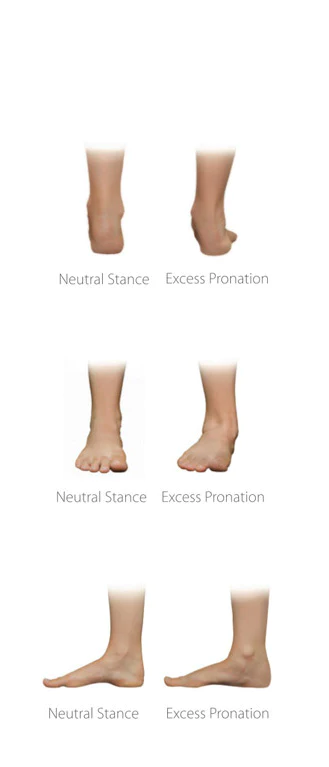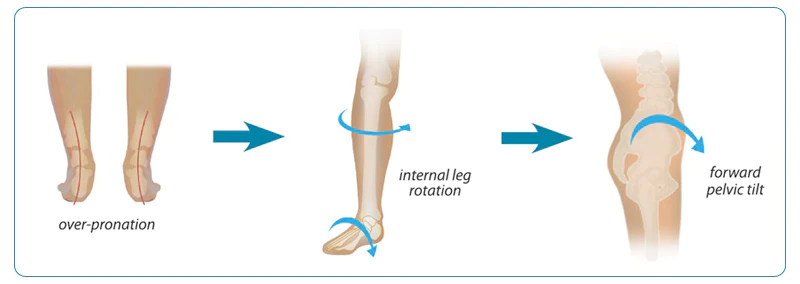The Gait Cycle
The science of walking comfort
Articles in this section
The illustrations below show the three phases of the ground phase.
1. Contact Phase:
- foot strikes on the outside of the heel with a 3- 4 degree ‘Tibial Varum angle’
- foot pronates and turns into a loose mobile adaptor and forms a natural shock-absorbing mechanism
- lower leg rotates internally
2. Midstance phase:
- foot converts from mobile adaptor into a rigid lever, preparing for propulsion
- foot starts to supinate
- lower leg starts to rotate externally
3. Propulsive phase:
- heel lifts off the ground
- rearfoot + forefoot lock together
- foot continues to supinate
- lower leg continues to rotate externally
Normal foot function
Normal foot function is represented by a natural cycle of pronation and supination, accompanied by internal and external rotation of the lower leg (see diagrams above). Abnormal foot function is commonly associated with Excess Pronation. At contact phase the lower limb approaches the ground with a slight angle of 3-4 degrees. This natural strike angle is referred to as the ‘Tibial Varum Angle’. As a result, the foot strikes on the outside of the calcaneus (heel bone). Next, the foot’s bone and muscle structures loosen and the foot pronates at the Subtalar Joint. This is our natural shock absorbing mechanism and it allows our feet to adapt to whatever surface we walk on.
During midstance the foot converts from mobile adaptor into a rigid lever, preparing for propulsion (supination). As the foot supinates the lower leg starts to rotate externally.
Excessive pronation
The problem occurring in many people is that during midstance the foot continues to pronate and remain loose, not allowing the foot to supinate (roll outwards) and become rigid in preparation for the propulsive phase.
Excess Pronation is very common, affecting at least half of the population. It can be attributed to different factors, including the hard, unnatural surfaces we walk on, unsupportive footwear, weak or fatigued muscles, age, body weight, arthritis, genetic factors etc.
The photos to the right show the right foot in neutral stance (Subtalar Joint in neutral, during midstance phase), as well as pronated excessively. Please take note of how the medial maleolus (inside ankle bone) is clearly protruded with excess pronation, and longitudinal arch is lowered significantly. Excess pronation commonly exhibits:
- Calcaneal eversion
- Internal tibial rotation
- Lowering and elongation of the longitudinal arch
- Excess medial lower limb stress
- Medial plantar displacement of the talus upon the calcaneus
- Excess weight bearing over the 1st metatarso-phalangeal joint
How excess pronation causes common biomechanical complaints..
Excess pronation may contribute to a wide range of biomechanical complaints from Plantar Fasciitis to low back pain. Our feet are the foundation of our body. Much like bad wheel alignment on a car, badly aligned feet can have a profound effect on our legs, knees, hips and lower back. For example, excess pronation causes internal rotation of the tibia, which in turn leads to mal-tracking of the patella over the femur. Internal tibial rotation also leads to forward pelvic tilt, causing strain in the lower back muscles.
Orthotic therapy
The use of foot orthoses in the treatment of common biomechanical complaints has become more widespread in the last 10 years. An ever increasing number of studies have shown the benefits of orthotic therapy for conditions such as heel pain, knee pain and low back pain. Many physiotherapists and chiropractors in the UK have added orthotics to their range of treatment options, recognising that poor foot biomechanics may contribute to complaints in other parts of the body.
Footlogics orthotics
Developed by podiatrists, Footlogics orthotics address the problem of excess pronation by re-aligning the lower limb to a more natural position. By restoring normal foot function, Footlogics orthotics also help improve overall body posture.
Footlogics’ unique anatomical design and material composition provide your patient with excellent walking comfort, helping to alleviate a range of different conditons. Footlogics orthotics are made of a firm density EVA, combined with a soft upper layer of Durapontex® for added walking comfort. Different models of orthotics are available to suit different types of footwear and conditions. With Footlogics you can offer your patient effective and affordable orthotic therapy.



